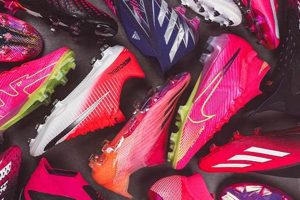When it comes to playing rugby, having the right footwear is essential. For women, finding the perfect pair of rugby cleats can make all the difference in their performance on the field.
Editor’s Note:Women’s rugby cleats are a crucial piece of equipment for any female rugby player. They provide the necessary support, traction, and protection needed to perform at their best.
To help women rugby players make the right decision when choosing a pair of cleats, we’ve done the research and put together this comprehensive guide. We’ll cover everything from the different types of cleats available to the key features to look for when making a purchase.
Key Differences
While women’s and men’s rugby cleats may look similar, there are actually some key differences between the two. These differences are designed to accommodate the specific needs of female rugby players.
| Feature | Women’s Rugby Cleats | Men’s Rugby Cleats |
|---|---|---|
| Last | Narrower and designed to fit the female foot | Wider and designed to fit the male foot |
| Weight | Lighter than men’s cleats | Heavier than women’s cleats |
| Cleats | Shorter and less aggressive than men’s cleats | Longer and more aggressive than women’s cleats |
Main Article Topics
In this guide, we’ll cover the following topics:
- The different types of women’s rugby cleats available
- The key features to look for when choosing a pair of cleats
- How to care for your cleats
- Tips for choosing the right cleats for your needs
1. Fit
The fit of your women’s rugby cleats is one of the most important factors to consider when choosing a pair. Cleats that are too loose can cause blisters and other injuries, while cleats that are too tight can restrict your movement and cause discomfort. It’s important to find a pair of cleats that fit snugly but not too tightly, and that provide good support for your arch and ankle.
There are a few things you can do to ensure a good fit. First, make sure to measure your feet before you start shopping for cleats. This will help you determine your correct size. Second, when you’re trying on cleats, be sure to wear the socks that you plan to wear when you’re playing rugby. This will help you get a better sense of how the cleats will fit.
Once you’ve found a pair of cleats that fit well, be sure to break them in before you wear them in a game. This will help to prevent blisters and other injuries.
Benefits of a good fit
- Prevents blisters and other injuries
- Improves performance by providing good support for the arch and ankle
- Makes playing rugby more comfortable
Consequences of a bad fit
- Blisters and other injuries
- Reduced performance due to lack of support
- Discomfort
Tips for finding a good fit
- Measure your feet before you start shopping for cleats.
- When you’re trying on cleats, be sure to wear the socks that you plan to wear when you’re playing rugby.
- Walk around in the cleats to make sure they’re comfortable.
- Break in your cleats before you wear them in a game.
2. Weight
The weight of your women’s rugby cleats is an important factor to consider when choosing a pair. Cleats that are too heavy can weigh you down and make it difficult to move quickly and agility on the field. This can have a negative impact on your performance and increase your risk of injury.
Lightweight cleats, on the other hand, will allow you to move more freely and quickly, and will help you to conserve energy during the game. This can give you a competitive advantage and help you to perform at your best.
There are a number of lightweight women’s rugby cleats on the market, so you can find a pair that meets your needs and budget. When choosing a pair of cleats, be sure to consider the following factors:
- Material: Lightweight cleats are typically made from synthetic materials, such as nylon or mesh. These materials are strong and durable, but they are also lightweight and breathable.
- Construction: Lightweight cleats are often constructed with a minimalist design. This means that they have fewer seams and reinforcements, which reduces weight.
- Cleats: The cleats on lightweight cleats are typically shorter and less aggressive than the cleats on heavier cleats. This reduces weight and makes the cleats more suitable for playing on soft surfaces.
By considering these factors, you can choose a pair of lightweight women’s rugby cleats that will help you to perform your best on the field.
Benefits of lightweight cleats
- Improved performance due to increased mobility and agility
- Reduced risk of injury due to less fatigue
- Increased comfort due to less weight
Consequences of heavy cleats
- Reduced performance due to decreased mobility and agility
- Increased risk of injury due to more fatigue
- Decreased comfort due to more weight
Tips for choosing lightweight cleats
- Look for cleats made from lightweight materials, such as nylon or mesh.
- Choose cleats with a minimalist design.
- Select cleats with shorter and less aggressive cleats.
3. Durability
Durability is an essential quality for women’s rugby cleats. The game of rugby is tough and demanding, and cleats that are not durable enough will quickly break down. This can lead to injuries, as well as reduced performance on the field.
There are a number of different materials that can be used to make rugby cleats. Some of the most common materials include leather, synthetic leather, and rubber. Leather cleats are the most durable, but they are also the most expensive. Synthetic leather cleats are a good compromise between durability and cost. Rubber cleats are the least durable, but they are also the lightest and most flexible.
When choosing a pair of women’s rugby cleats, it is important to consider the type of material that the cleats are made from. If you are looking for a pair of cleats that will last for a long time, then you should choose a pair that is made from leather or synthetic leather. If you are looking for a pair of cleats that are lightweight and flexible, then you should choose a pair that is made from rubber.
Benefits of durable cleats
- Increased longevity
- Reduced risk of injury
- Improved p
erformance
Consequences of non-durable cleats
- Decreased longevity
- Increased risk of injury
- Reduced performance
Tips for choosing durable cleats
- Look for cleats that are made from high-quality materials, such as leather or synthetic leather.
- Choose cleats that have reinforced stitching and construction.
- Avoid cleats that have a lot of exposed seams or glue.
4. Traction
Traction is essential for women’s rugby cleats because it helps players to stay on their feet in all conditions, even on wet or muddy surfaces. Good traction can help players to accelerate, decelerate, and change direction quickly and safely, which is essential for playing rugby at a high level.
- Stud Pattern: The stud pattern of a rugby cleat is the arrangement of the studs on the bottom of the cleat. Different stud patterns are designed for different types of surfaces, so it is important to choose a cleat with a stud pattern that is appropriate for the surfaces you will be playing on. For example, cleats with a longer stud pattern are better for soft surfaces, while cleats with a shorter stud pattern are better for hard surfaces.
- Stud Material: The material of the studs on a rugby cleat can also affect traction. Studs made from harder materials, such as metal or hard plastic, will provide more traction on hard surfaces. Studs made from softer materials, such as rubber or TPU, will provide more traction on soft surfaces.
- Cleat Height: The height of the studs on a rugby cleat can also affect traction. Taller studs will provide more traction on soft surfaces, while shorter studs will provide more traction on hard surfaces.
- Weight: The weight of a rugby cleat can also affect traction. Heavier cleats will provide more traction on soft surfaces, while lighter cleats will provide more traction on hard surfaces.
By considering these factors, you can choose a pair of women’s rugby cleats that will provide you with the best possible traction for your playing conditions.
5. Comfort
Comfort is an essential factor to consider when choosing a pair of women’s rugby cleats. Rugby is a physically demanding sport that requires players to be on their feet for long periods of time. Wearing uncomfortable cleats can lead to blisters, foot pain, and other injuries. It can also make it difficult to focus on the game and perform at your best.
- Cushioning: The cushioning in a rugby cleat can help to absorb impact and reduce foot fatigue. Look for cleats with a cushioned midsole and insole.
- Fit: The fit of a rugby cleat is also important for comfort. Cleats that are too tight or too loose can cause blisters and other injuries. Make sure to try on cleats before you buy them to ensure a good fit.
- Breathability: Breathable cleats will help to keep your feet cool and dry. Look for cleats with a mesh upper or other breathable materials.
- Support: The support in a rugby cleat can help to prevent ankle injuries. Look for cleats with a supportive ankle collar and arch support.
By considering these factors, you can choose a pair of women’s rugby cleats that are comfortable to wear for long periods of time and that will help you to perform at your best.
6. Style
The style of your women’s rugby cleats is a personal choice. There are a variety of styles to choose from, so you can find a pair that matches your personality and playing style. Some popular styles of women’s rugby cleats include:
- Classic: Classic rugby cleats are designed for performance and durability. They typically have a leather or synthetic leather upper, a cushioned midsole, and a rubber outsole with metal studs.
- Modern: Modern rugby cleats are designed for speed and agility. They typically have a lightweight synthetic upper, a responsive midsole, and a rubber outsole with plastic studs.
- Fashionable: Fashionable rugby cleats are designed to make a statement. They typically have a unique upper design, a bold color scheme, and a variety of embellishments.
- Custom: Custom rugby cleats are designed to meet the specific needs of individual players. They can be made from a variety of materials and can be customized with a variety of features, such as different stud patterns, colors, and logos.
No matter what your personal style, there is a pair of women’s rugby cleats that is perfect for you. So take some time to browse the different styles available and find a pair that you love.
7. Brand
When choosing a pair of women’s rugby cleats, it is important to consider the brand. There are a number of different brands of women’s rugby cleats available, each with its own unique strengths and weaknesses. Some of the most popular brands of women’s rugby cleats include Nike, Adidas, Under Armour, and Canterbury.
- Nike: Nike is one of the most popular brands of women’s rugby cleats in the world. Nike cleats are known for their quality, durability, and performance. Nike also offers a wide range of women’s rugby cleats to choose from, so you can find a pair that meets your specific needs.
- Adidas: Adidas is another popular brand of women’s rugby cleats. Adidas cleats are known for their comfort, support, and style. Adidas also offers a wide range of women’s rugby cleats to choose from, so you can find a pair that fits your budget and your needs.
- Under Armour: Under Armour is a newer brand of women’s rugby cleats, but it has quickly become one of the most popular brands on the market. Under Armour cleats are known for their lightweight, breathable, and durable construction. Under Armour also offers a wide range of women’s rugby cleats to choose from, so you can find a pair that meets your specific needs.
- Canterbury: Canterbury is a leading brand of rugby apparel and equipment. Canterbury cleats are known for their quality, durability, and performance. Canterbury also offers a wide range of women’s rugby cleats to choose from, so you can find a pair that meets your specific needs.
When choosing a brand of women’s rugby cleats, it is important to consider your own needs and preferences. Some factors to consider include the brand’s reputation, the quality of the cleats, the price of the cleats, and the availability of the cleats. By considering these factors, you can choose a brand of women’s rugby cleats that is right for you.
8. Price
The price of women’s rugby cleats can vary depending on a number of factors, including the brand, the materials used, and the features offered. However, it is import
ant to remember that price is not always an indicator of quality. There are a number of affordable women’s rugby cleats on the market that offer excellent performance and durability. It is also important to consider your own needs and budget when choosing a pair of cleats. If you are a beginner, you may not need to spend a lot of money on a pair of cleats. However, if you are a serious player, you may want to invest in a pair of high-quality cleats that will provide you with the best possible performance.
Here are some of the factors that can affect the price of women’s rugby cleats:
- Brand: The brand of the cleats can have a significant impact on the price. Some brands, such as Nike and Adidas, are more expensive than others. However, there are also a number of affordable brands that offer high-quality cleats.
- Materials: The materials used to make the cleats can also affect the price. Cleats made from leather are typically more expensive than cleats made from synthetic materials. However, synthetic materials can be just as durable and comfortable as leather.
- Features: The features offered by the cleats can also affect the price. Cleats with a lot of features, such as ankle support and cushioning, are typically more expensive than cleats with fewer features.
It is important to consider all of these factors when choosing a pair of women’s rugby cleats. By doing so, you can find a pair of cleats that meets your needs and budget.
Table: Price Range of Women’s Rugby Cleats
| Price Range | Features | Examples |
|---|---|---|
| $50-$100 | Basic features, durable materials | Adidas Malice SG, Nike Tiempo Legend 8 Academy SG |
| $100-$150 | Mid-range features, improved materials | Under Armour Highlight MC, Canterbury Phoenix Stampede SG |
| $150-$200 | High-end features, premium materials | Nike Phantom GT2 Elite SG, Adidas Predator Freak.1 SG |
FAQs About Women’s Rugby Cleats
Women’s rugby cleats are an essential piece of equipment for any female rugby player. They provide the necessary support, traction, and protection needed to perform at their best on the field. However, choosing the right pair of cleats can be a daunting task, especially for those new to the sport.
To help you make an informed decision, we’ve compiled a list of frequently asked questions (FAQs) about women’s rugby cleats.
Question 1: What are the key features to look for when choosing a pair of women’s rugby cleats?
When choosing a pair of women’s rugby cleats, there are several key features to consider, including fit, weight, durability, traction, comfort, style, brand, and price. It’s important to choose a pair of cleats that meet your specific needs and preferences.
Question 2: What are the different types of women’s rugby cleats available?
There are three main types of women’s rugby cleats: classic, modern, and fashionable. Classic cleats are designed for performance and durability, modern cleats are designed for speed and agility, and fashionable cleats are designed to make a statement.
Question 3: How do I choose the right size of women’s rugby cleats?
To choose the right size of women’s rugby cleats, it’s important to measure your feet and try on different sizes to ensure a snug but not too tight fit. It’s also important to consider the type of socks you’ll be wearing when playing rugby.
Question 4: How do I care for my women’s rugby cleats?
To care for your women’s rugby cleats, it’s important to clean them after each use with a damp cloth and mild soap. You should also store your cleats in a dry, well-ventilated area.
Question 5: How often should I replace my women’s rugby cleats?
The frequency with which you should replace your women’s rugby cleats will vary depending on how often you play and the type of cleats you have. However, it’s generally recommended to replace your cleats every 6-12 months.
Question 6: What are some tips for choosing the right women’s rugby cleats?
Here are a few tips for choosing the right women’s rugby cleats:
- Consider your playing style and the type of surfaces you’ll be playing on.
- Try on different cleats to find a pair that fits comfortably and snugly.
- Pay attention to the materials and construction of the cleats to ensure durability.
- Choose a pair of cleats that you like the look of and that fit your budget.
By following these tips, you can choose a pair of women’s rugby cleats that will help you perform your best on the field.
Summary: Women’s rugby cleats are an important piece of equipment for any female rugby player. By choosing the right pair of cleats, you can improve your performance, reduce your risk of injury, and enjoy the game more.
Transition: Now that you know more about women’s rugby cleats, you can start shopping for the perfect pair. Be sure to consider your specific needs and preferences when making your decision.
Women’s Rugby Cleats
Choosing the right pair of women’s rugby cleats is essential for optimal performance and injury prevention on the field. Here are some crucial tips to guide your decision-making process:
Tip 1: Prioritize Fit and Comfort
Ensure a snug but not constricting fit to prevent blisters and discomfort. Try on different sizes and consider the thickness of socks you’ll wear during matches.
Tip 2: Consider Your Playing Style and Surfaces
Select cleats designed for your specific playing style and the type of surfaces you’ll encounter. Forwards may prefer cleats with more support and durability, while backs may opt for lightweight and agile options.
Tip 3: Evaluate Materials and Construction
Look for cleats made from durable materials like leather or synthetic leather. Inspect the stitching and construction to ensure they can withstand the rigors of the game.
Tip 4: Choose Appropriate Studs
The length and configuration of studs impact traction and stability. Longer studs provide better grip on soft surfaces, while shorter studs offer more agility on hard surfaces. Consider the playing conditions you’ll face.
Tip 5: Break In Your Cleats Gradually
Avoid wearing new cleats for extended periods initially. Gradually increase usage to prevent discomfort or injuries. Break them in during training sessions or light activities.
Tip 6: Clean and Maintain Your Cleats
After each use, clean your cleats with a damp cloth and mild soap. Allow them to dry thoroughly before storing them in a dry and well-ventilated area. Regular maintenance extends their lifespan.
Summary: By following these tips, you can choose a pair of women’s rugby cleats that provide the necessary support, protection, and performance enhancement while minimizing the risk of injuries and discomfort on the field.
Transition: With the right cleats, you’ll be equipped to tackle the challenges of the game with confidence and achieve your full potential as a rugby player.
Conclusion
Women’s rugby cleats are an essential piece of equipment for female rugby players. They provide the necessary support, traction, and protection needed to perform at their best on the field. Choosing the right pair of cleats can make all the difference in a player’s performance and safety.
This comprehensive guide has explored the various aspects of women’s rugby cleats, including their key featur
es, types, and essential tips for choosing the right pair. By considering the factors discussed in this article, female rugby players can make informed decisions that will enhance their playing experience and contribute to their overall success on the field.







